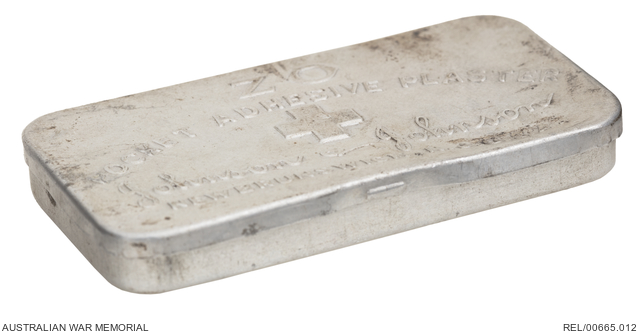| Accession Number | REL/00665.012 |
|---|---|
| Collection type | Heraldry |
| Object type | Heraldry |
| Physical description | Aluminium |
| Maker |
Johnson & Johnson, New Brunswick N.J. USA |
| Place made | United States of America: New Jersey |
| Date made | c 1914-1918 |
| Conflict |
First World War, 1914-1918 |
| Source credit to | This item has been digitised with funding provided by Commonwealth Government. |
Pocket adhesive plaster : Corporal F J Orr, 1st Australian Army Pay Corps, AIF



Small rectangular hinged aluminium container. The lid is embossed with a [red] cross in the centre, and 'ZO POCKET ADHESIVE PLASTER Johnson & Johnson NEW BRUNSWICK, N.J. U.S.A.'. The contents are no longer present.
Formed part of a ‘Tabloid’ first aid kit carried during his wartime service by Francis James Orr. Born at Maredon, Victoria, Orr was aged 24 years four months and working as a postal assistant when he enlisted on 17 April 1916 and was assigned service number 1957. He received training in signals at Broadmeadows before embarking for England aboard the transport ‘Orontes’ on 16 August 1916. After further training, he was assigned to 39 Battalion on 10 October, before being attached to the 1st Australian Army Pay Corps on 29 October. Promoted to lance corporal on 1 February 1917 and to temporary sergeant 1 February 1919, Orr remained with the Pay Corps until the end of the war. He returned to Australia aboard the transport ‘Boonah’ and was discharged from the AIF on 17 July 1919.
The civilian ‘Tabloid’ brand kits were made by the London pharmaceutical company Burroughs and Wellcome, which produced a wide range of sizes and contents depending on their intended use; specialised kits were provided by the company to a number of North and South Pole expeditions prior to the First World War. This particular kit, contained in a gilded ‘Tabloid First Aid’ tin, would have been a fairly standard kit, containing chocolate-coated quinine, carron oil for burns and scalds, castor oil, smelling salts, plasters, headache powders and needles.